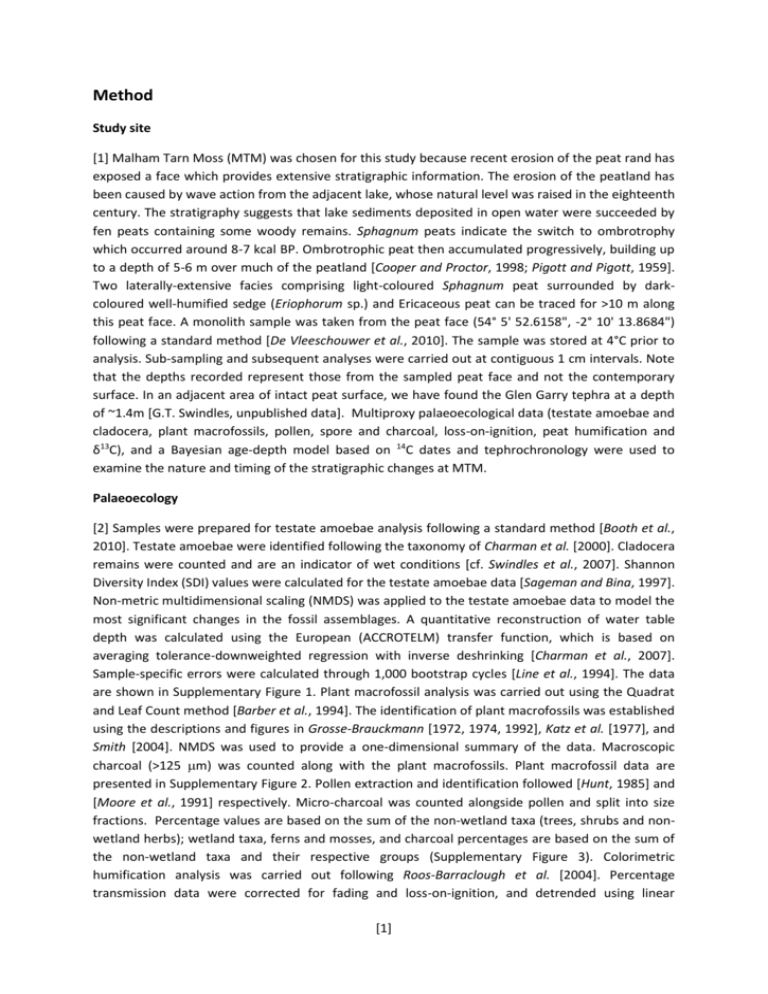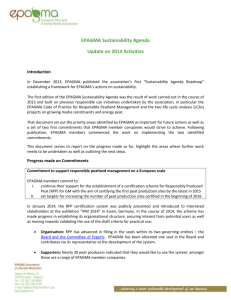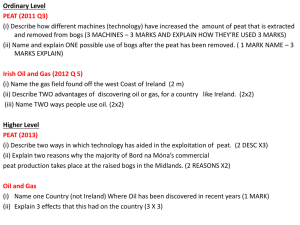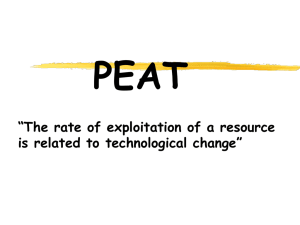grl29151-sup-0001-txts01
advertisement

Method Study site [1] Malham Tarn Moss (MTM) was chosen for this study because recent erosion of the peat rand has exposed a face which provides extensive stratigraphic information. The erosion of the peatland has been caused by wave action from the adjacent lake, whose natural level was raised in the eighteenth century. The stratigraphy suggests that lake sediments deposited in open water were succeeded by fen peats containing some woody remains. Sphagnum peats indicate the switch to ombrotrophy which occurred around 8-7 kcal BP. Ombrotrophic peat then accumulated progressively, building up to a depth of 5-6 m over much of the peatland [Cooper and Proctor, 1998; Pigott and Pigott, 1959]. Two laterally-extensive facies comprising light-coloured Sphagnum peat surrounded by darkcoloured well-humified sedge (Eriophorum sp.) and Ericaceous peat can be traced for >10 m along this peat face. A monolith sample was taken from the peat face (54° 5' 52.6158", -2° 10' 13.8684") following a standard method [De Vleeschouwer et al., 2010]. The sample was stored at 4°C prior to analysis. Sub-sampling and subsequent analyses were carried out at contiguous 1 cm intervals. Note that the depths recorded represent those from the sampled peat face and not the contemporary surface. In an adjacent area of intact peat surface, we have found the Glen Garry tephra at a depth of ~1.4m [G.T. Swindles, unpublished data]. Multiproxy palaeoecological data (testate amoebae and cladocera, plant macrofossils, pollen, spore and charcoal, loss-on-ignition, peat humification and δ13C), and a Bayesian age-depth model based on 14C dates and tephrochronology were used to examine the nature and timing of the stratigraphic changes at MTM. Palaeoecology [2] Samples were prepared for testate amoebae analysis following a standard method [Booth et al., 2010]. Testate amoebae were identified following the taxonomy of Charman et al. [2000]. Cladocera remains were counted and are an indicator of wet conditions [cf. Swindles et al., 2007]. Shannon Diversity Index (SDI) values were calculated for the testate amoebae data [Sageman and Bina, 1997]. Non-metric multidimensional scaling (NMDS) was applied to the testate amoebae data to model the most significant changes in the fossil assemblages. A quantitative reconstruction of water table depth was calculated using the European (ACCROTELM) transfer function, which is based on averaging tolerance-downweighted regression with inverse deshrinking [Charman et al., 2007]. Sample-specific errors were calculated through 1,000 bootstrap cycles [Line et al., 1994]. The data are shown in Supplementary Figure 1. Plant macrofossil analysis was carried out using the Quadrat and Leaf Count method [Barber et al., 1994]. The identification of plant macrofossils was established using the descriptions and figures in Grosse-Brauckmann [1972, 1974, 1992], Katz et al. [1977], and Smith [2004]. NMDS was used to provide a one-dimensional summary of the data. Macroscopic charcoal (>125 m) was counted along with the plant macrofossils. Plant macrofossil data are presented in Supplementary Figure 2. Pollen extraction and identification followed [Hunt, 1985] and [Moore et al., 1991] respectively. Micro-charcoal was counted alongside pollen and split into size fractions. Percentage values are based on the sum of the non-wetland taxa (trees, shrubs and nonwetland herbs); wetland taxa, ferns and mosses, and charcoal percentages are based on the sum of the non-wetland taxa and their respective groups (Supplementary Figure 3). Colorimetric humification analysis was carried out following Roos-Barraclough et al. [2004]. Percentage transmission data were corrected for fading and loss-on-ignition, and detrended using linear [1] regression following standard procedures [Blackford and Chambers, 1993]. The peat subsamples (2 cm3) were dried at 105 °C for approximately 12 hours and then combusted in a muffle furnace at 450°C for 8 hours to calculate percentage loss-on-ignition [Schulte and Hopkins, 1996]. Carbon isotope analysis was done on a Flash EA 1112 connected via a Conflo III to a Delta Plus XL mass spectrometer at the University of Bradford. Peat and geochemical data are shown in Supplementary Figure 4. Chronology [3] Tephra was detected in the peat sequence following Swindles et al. [2010]. Geochemistry was analysed using the Jeol FEG SEM 6500F INCAWave system at Queen's University Belfast, with an accelerating voltage of 15 kV, a 5 nA beam current, and a beam rastered to about 5x5 µm. Na, Mg, Mn and Ti were analysed by WDS and Si, Al, Fe, K, Ca by EDS following Coulter et al. [2009]. The results indicate a homogenous population of dacitic-rhyolitic tephra that match the distinctive chemistry of the Glen Garry tephra (Supplementary Table 1, Supplementary Figure 5). This tephra has been widely reported from Britain where is has been dated by 14C wiggle-matching to 2210– 1966 cal. BP [Barber et al., 2008]. Sphagnum leaves and stems were extracted from the peat samples and submitted for AMS 14C dating at 14Chrono (Queen’s University Belfast) (Supplementary Table 2). An age-depth model was produced using all 10 14C dated depths together with the published 14C age of Glen Garry (2139 ±61 14C BP). In order to accommodate potential outlying dates, the dates were calibrated applying a Student’s-t distribution with default parameters a = 3 and b = 4 [Christen and Perez, 2009], using the northern hemisphere calibration curve [Reimer et al., 2009]. Peat accumulation rates and their variability were constrained by prior information using the Bayesian age-depth software Bacon [Blaauw and Christen, 2011]. Bacon divides a core into thin vertical sections (here 22 sections of 2 cm width) and models the accumulation rate of each section by sampling from prior distributions of accumulation rate and its variability. A degree of memory is assumed between neighbouring depths, with high memory causing near constant accumulation rates and low memory causing more variable rates. As prior for accumulation rate we used a gamma distribution with shape 2 and mean 20 (yr cm-1), while for the memory we used a beta distribution with strength 4 and mean 0.7. The resulting age-depth model is shown in Supplementary Figure 6. Date UBA-14644 is a clear outlier. 95% confidence intervals range from 90 yr at 11 cm depth to c. 200-260 yr at the top and bottom of the core where extrapolation beyond the dates was required (using the accumulation model described above). Modelling [4] We used the model of Morris et al. [2011a] to simulate a virtual bog (an artificial ecology) with similar properties to MTM. The virtual bog allowed us to perform numerical experiments to investigate how peatland water tables respond to climatic changes. With one modification (see below), we used Model 3 from [Morris et al., 2011a] for our simulations. The model simulates 1-D peat accumulation in the centre of a peatland and has the following state variables: peatland height, water-table position, degree of decomposition of the peat through the peat profile, and permeability of the peat through the peat profile. The model contains a number of ecohydrological feedbacks and linkages, including the link between rates of litter production and water-table depth, and that between peat permeability and degree of peat decomposition. The addition of new peat (litter) at the peatland surface is described by a quartic function first presented by Belyea and Clymo [2] [2001] and based on data from a raised bog in SW Scotland. The function is similar to that used in other peatland development models such the ‘mixed model’ described in Hilbert et al. [2000]. Peat decomposition is simulated in our model using a simple proportionate decay rate submodel [Clymo, 1984], with different decay coefficients – (T-1) – set for conditions above the water table (assumed oxic – ox) and below the water table (assumed anoxic – an). In the simulations shown, we set an and ox to, respectively, 0.0001 and 0.03 yr-1. These values are within measured ranges for the litter and peat found in northern raised bogs [cf. Morris et al., 2011b]. Peat permeability (or, more correctly, hydraulic conductivity as defined by Darcy’s law [McWhorter and Sunada, 1977]) is a function of degree of decomposition in the model and decreases exponentially with 1-, where is the proportion of the mass remaining in a cohort of peat or litter. As peat decomposes, decreases. The parameters used in the permeability function were the same as used in Model 3 in [Morris et al., 2011a], giving a value of hydraulic conductivity of 2.98 × 10-2 m s-1 (3 sig. figures) when = 1, and 2.23 × 10-5 m s-1 when = 0.1. Water is added to the virtual peatland simulated in the model as a net rainfall (U – precipitation minus evapotranspiration) specified by the user. We set the net rainfall prior to the step increases reported in the main paper to 1000 mm yr-1, which is based on recent (last 100 years) records from the site [Bullock, 1971; Burt and Horton, 2003]. The drainable porosity of the peat was set to 0.3 (dimensionless) [Vorob’ev, 1963]. Water flow via seepage from the peatland was simulated using the Boussinesq equation [McWhorter and Sunada, 1977], a simplified version of Darcy’s law linked with the balance equation. The version of the Boussinesq equation that we used describes radial flow outwards from the centre of a circular bog [cf. Ingram, 1987] and differs from that used in [Morris et al., 2011a] where flow to the margin of a linear bog between two parallel streams was used. To apply the Boussinesq equation it is necessary to specify the distance from the centre of a bog to its margin. We set this as 200 m (so the virtual bog had a diameter of 400 m). There are three peat domes at MTM. The dome from which the peat samples for the reconstruction of palaeo water tables were taken is not perfectly circular and abuts another dome. In the model, the dome was represented as equivalent to a circle with a diameter of 400 m. The model was run for 5790 years prior to the step changes in rainfall. The initiation date of the virtual peatland (~8000 years ago) corresponds to estimates of bog peat initiation at MTM from pollen biostratigraphic data [Pigott and Pigott, 1959; Bennett, 1988]. Supplementary references (not in main text) Barber, K. E., F. M. Chambers, D. Maddy, R. Stoneman, and J. S. Brew (1994), A sensitive high resolution record of late Holocene climatic change from a raised bog in northern England, Holocene, 4, 198-205. Barber, K., P. Langdon, and A. Blundell (2008), Dating the Glen Garry tephra: a widespread lateHolocene marker horizon in the peatlands of northern Britain, Holocene, 18, 31-43. Bennett, K. D. (1988), Holocene pollen stratigraphy of central East Anglia, England, and comparison of pollen zones across the British Isles, New Phytologist, 109, 237-253. Blackford, J. J., and F. M. Chambers (1993), Determining the degree of peat decomposition for peatbased palaeoclimatic studies, International Peat Journal, 5, 7-24. Booth, R. K., M. Lamentowicz, and D. J. Charman (2010), Preparation and analysis of testate amoebae in peatland paleoenvironmental studies, Mires and Peat, 7, 7 pp. [3] Bullock, P. (1971), The soils of the Malham Tarn area, Field Studies, 3, 381-408. Burt, T. P., and B. P. Horton (2003), The climate of Malham Tarn, Field Studies, 10, 635-652. Charman, D. J., D. Hendon, and W. A. Woodland (2000), The identification of testate amoebae (Protozoa: Rhizopoda) in peats, Quaternary Research Association, Oxford. Christen, J. A., and S. Perez (2009), A new robust statistical model for radiocarbon data, Radiocarbon, 51, 1047-1059. Clymo, R. S. (1984), The limits to peat bog growth, Philosophical Transactions of the Royal Society of London B, 303, 605-654. Cooper, E. A., and M. C. F Proctor (1998), Malham Tarn National Nature Reserve: the vegetation of Malham Tarn Moss and fens, Field Studies, 9, 277-312. Coulter, S. E., C. S. M. Turney, P. Kershaw, and S. Rule (2009), The characterization and significance of a MIS 5a distal tephra on mainland Australia, Quaternary Science Reviews, 28, 1825-1830. De Vleeschouwer, F., F. M. Chambers, and G. T. Swindles (2010), Coring and sub-sampling of peatlands for palaeoenvironmental research, Mires and Peat, 7, 10 pp. Grosse-Brauckmann, G. (1972), Über pflanzliche Makrofossilien mitteleuropäischer Torfe. I. Gewebereste krautiger Pflanzen und ihre Merkmale, Telma, 2, 19-55. Grosse-Brauckmann, G. (1974), Über pflanzliche Makrofossilien mitteleuropäischer Torfe. II. Weitere Reste (Früchte und Samen, Moose u.a.) und ihre Bestimmungsmöglichkeiten, Telma, 4, 51117. Grosse-Brauckmann, G. (1992), Über pflanzliche Makrofossilien mitteleuropäischer Torfe. III. Früchte, Samen und einige Gewebe (Fotos von fossilen Pflanzenresten), Telma, 22, 53-102. Hilbert, D. W., N. T. Roulet, and T. Moore (2000), Modelling and analysis of peatlands as dynamical systems, Journal of Ecology, 88, 230-242. Hunt, C. O. (1985), Recent advances in pollen extraction techniques, in Paleobiological Investigations: Research Design, Methods and Data Analysis, BAR British Series, vol. 266, edited by Fieller, N. R. J., D. D. Gilbertson, and N. G. A. Ralph, BAR, Oxford. Ingram, H. A. P. (1987), Ecohydrology of Scottish peatlands, Transactions of the Royal Society of Edinburgh: Earth Sciences, 78, 287-296. Katz, N. J., S. V. Katz, and E. I. Skobeyeva (1977), Atlas Rastitel'nyh Oostatkov v Torfje (Atlas of Plant Remains in Peats), Nedra, Moscow. Line, J. M., C. J. F. ter Braak, and H. J. B. Birks (1994), WACALIB version 3.3 – a computer program to reconstruct environmental variables from fossil assemblages by weighted averaging and to derive sample-specific errors of prediction, Journal of Paleolimnology, 10, 147-152. McWhorter, D. B., and D. K. Sunada (1977), Ground-water Hydrology and Hydraulics, Water Resources Publications, Fort Collins, Colorado. [4] Moore, P. D., J. A. Webb, and M. E. Collinson (1991), Pollen Analysis, 2nd ed., Blackwell Scientific Publications, Oxford. Morris, P., A. J. Baird, and L. R. Belyea (2011), The DigiBog model of peatland development 2: ecohydrological simulations in 2-D, Ecohydrology, doi: 10.1002/eco.229. Pigott, M. E., and C. D. Pigott (1959), Stratigraphy and pollen analysis of Malham Tarn and Tarn Moss, Field Studies, 1, 84-101. Reimer, P. J. et al. (2009), Intcal09 and Marine09 Radiocarbon Age Calibration Curves, 0-50,000 Years Cal Bp, Radiocarbon, 51, 1111-1150. Roos-Barraclough, F., W. O. van der Knaap, J. F. N. van Leeuwen, and W. A. Shotyk (2004), Lateglacial and Holocene record of climatic change from a Swiss peat humification profile, Holocene, 14, 7-19. Sageman, B. B., and C. R. Bina (1997), Diversity and species abundance patterns in Late Cenomanian black shale biofacies, Western Interior, US, Palaios, 12, 449-466. Schulte, E. E., and B. G. Hopkins (1996), Estimation of soil organic matter by weight loss-on-ignition, in Soil Organic Matter: Analysis and Interpretation, SSSA Spec. Publ., edited by Magdoff, F. R. E., M. A. E. Tabatabai, and E. A. E. Hanlon, SSSA, Madison. Smith, J. E. (2004), The Moss Flora of Britain and Ireland, 2nd ed., Cambridge University Press, Cambridge. Swindles, G. T., F. De Vleeschouwer, and G. Plunkett (2010), Dating peat profiles using tephra: stratigraphy, geochemistry and chronology, Mires and Peat, 7, 1-9. Swindles, G. T., G. Plunkett, and H. M. Roe (2007), A multiproxy climate record from a raised bog in County Fermanagh, Northern Ireland: a critical examination of the link between bog surface wetness and solar variability, Journal of Quaternary Science, 22, 667-679. Vorob’ev, P. K. (1963), Investigations of water yield of low lying swamps of Western Siberia, Transactions of the State (Soviet Union) Hydrologic Institute, 105, 45-79. [5]









